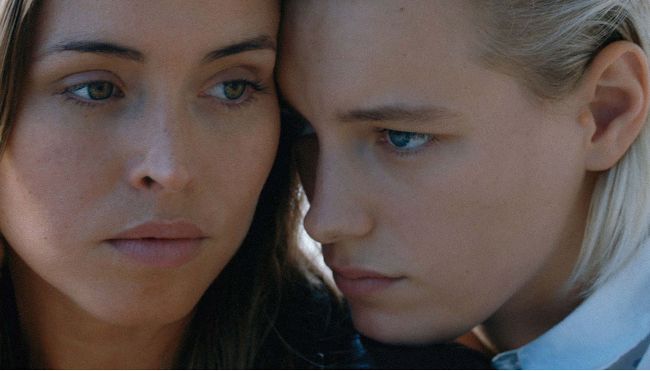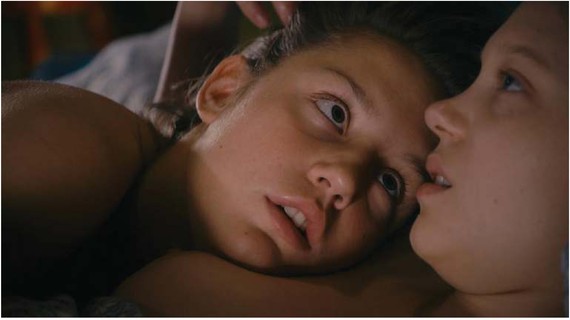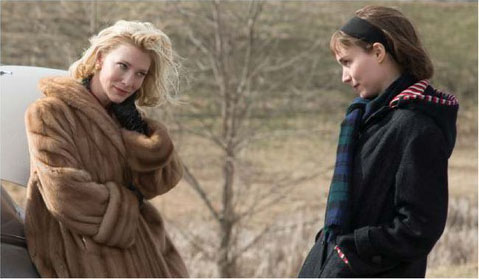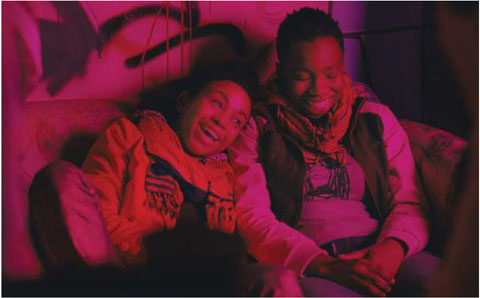Lesbian Rep
Directed by a queer woman, with an all- female crew, the ilm Below Her Mouth has been lauded and panned for its graphic female sex scenes, but is it a step forward for lesbian representation, or just more of the same? Róisín McVeigh charts the evolution of the modern lesbian on screen, and inds it’s still a straight, white man’s game ater all.

Natalie Krill and Erika Linder in Below Her Mouth, 2017
For most of Hollywood’s lifetime lesbian characters have been invisible or concealed in mainstream cinema, and even written out of stories for reasons that were once lawful (the Hays Code), and later commercial. While lesbian characters and stories are becoming increasingly more prevalent, their representations remain largely unsatisfying. Since the ’80s, the same-sex genre has made strides to shake off Hollywood taboos and clichés. In Desert Hearts (1985), the comedic/melodramatic and glamorous portrayal of a love affair between two women was considered revelatory.
It was the first time a lesbian couple had been portrayed in a positive light. But I’m a Cheerleader’s (1999) satirical telling of a closeted high school cheerleader who gets sent to straight camp triumphed in its unapologetic queerness and mockery of homophobia. Elsewhere with the casting of stars such as Angelina Jolie in Gia (1998) and Meryl Streep in The Hours (2002), lesbian stories slowly crept into mainstream cinema. These films paved the way for the new age of lesbian cinema making headlines and garnering award nominations this side of the millennium. New films of this genre are put on a pedestal, often considered groundbreaking and dubbed as ‘art-house’, despite still falling prey to the many tropes of the mainstream film industry. Like Blue is the Warmest Colour, Carol and Pariah before it, Below Her Mouth is the latest love story between two women to be both hyped and put under the microscope.

Léa Seydoux and Adèle Exarchopoulos in Blue is The Warmest Colour, 2013
Below Her Mouth makes its Irish premiere at the GAZE film festival this month. It has been both lauded and criticised for its brazen portrayal of lesbian sex. The film tells the story of an immediate and overwhelming lust between two characters, Dallas and Jasmine. Unfortunately it fails to present much else.
There is no question that the sex scenes, shot by queer director April Mullen, and her all-female crew, are brave. She eases the audience in by becoming increasingly experimental with each sexual encounter. In one formidable scene, Jasmine’s fiancé walks in on Dallas penetrating Jasmine with a strap-on as she is coming to climax. It’s an extremely jarring moment. The viewer can’t help but sympathise with all of the characters involved; we are as shocked as they are.
It’s adventurous filmmaking from Mullen and her crew, but Below Her Mouth is rinsed with all the familiar tropes we have come to expect from lesbian films: a masc-femme dynamic, hyper-sexualisation, a starkly white cast, and a miserable ending.
If it is such a double edged sword, why do lesbian ilms need to include a lengthy, jaw-dropping sex scene at all?
By comparison, Blue is the Warmest Colour (2013) succeeds in presenting a story of coup de foudre between two women that was both honest and passionate. We witness the protagonist Adéle in all her bambi-ish teenage glory. We see her stuff her face. We see her masturbate. We see her shrewdly avoid her boyfriend’s advances. We see her teased by schoolmates who suspect her sexuality. We see her fall hopelessly in love for the first time with older, sophisticated art student Emma. The intricate realism of the film creates a closeness between the viewer and Adéle. We see ourselves in her.
The film follows the pair as they embark on a wild romance, from initial flirtations to the eventual breakdown and demise of their relationship. Powered by the palpable intimacy between the two characters (played by Adéle Exarchopoulos and Léa Seydoux) and hinged on director Kechiche’s signature contemporary realism, Blue is not just a lesbian love story, but a universal tale of coming of age and all of the things that come with it, from first love to sexual discovery and finding one’s place in the world. Class and social structures are ultimately what drives a wedge between the couple. Emma begins to outgrow Adéle as she becomes further engrossed and entrenched in the upper echelons of the art world and the life that come with it, a life that cannot accommodate Adele. Blue is a film about class, but above all else it is about a life, love for love’s sake, and the inevitable breakdown of young love – in which the characters are also gay.
There was a lot riding on Blue is the Warmest Colour, as the first film of its kind to garner such global attention, it couldn’t afford to fail, and for the most part it didn’t. It opened to much hype and was widely acclaimed, receiving the prestigious Palme d’Or at Cannes Film Festival. The Guardian said “Abdellatif Kechiche’s epic film evokes love in its purest and most passionate form – intense, cataclysmic and unforgettable.”

Cate Blanchett and Rooney Mara in Carol, 2015
As oft happens once the hype dies down, the tide turned and criticisms began to swirl among critics and the LGBT+ community. Blue was put in the line of fire for its objectification of the protagonist Adele, and the inauthentic portrayal of lesbian sex. Rumors that the actresses were mistreated by Kechiche on set didn’t help. Julie Maraoh, the author of the original graphic novel, was quoted in the New York Times as saying: “Except for a few passages – this is all that it brings to my mind: a brutal surgical display, exuberant and cold, of socalled lesbian sex, which turned into porn and made me feel very ill at ease.” Although Maraoh found the adaptation to be “coherent, justified and fluid,” ultimately, “It appears to me that this was what was missing on the set: lesbians.”
Where one film failed, the other succeeded and vice versa. With Below Her Mouth, Mullen has accurately depicted lesbian sex, whereas Kechiche created an emotionally poignant story. But like a relationship, a movie can’t prevail when only based on sex. Both films have been ultimately criticised for sexual indulgence in one way or another. If it is such a double-edged sword, why do lesbian films need to include a lengthy, jaw-dropping sex scene at all?
There is a saying in France: “epater le bourgeoisie,” which essentially means to give the bourgeoise a kick up the arse. Regardless of its shortcomings, the significance of Blue is the Warmest Colour lies in it breaking new ground. Lesbians were being discussed around the dinner table, and not in a “look at yer one down the road” sort of way.
In Todd Haynes’ 2015 drama Carol, based on Patricia Highsmith’s 1952 novel The Price of Salt, we get the glamorisation of lesbians, maybe for the first time since Desert Hearts. In what is recognised as one of the most critically acclaimed lesbian film of all time, Cate Blanchett, a wealthy soon-to-be divorcé and a shop girl Rooney Mara forge an instant connection. They continue seeing each other and their mutual attraction grows. By including a tender but modest love scene, a complexity in the lesbians and an ending in which the characters aren’t doomed, Carol successfully avoids reifying tropes made in the past. For all it’s praise though, Carol is still yet another film about white, privileged lesbians.
Pariah (2011) has been potentially the most groundbreaking of all these modern lesbian films, and yet it has been severely underrated. In director Dee Rees’ semi-autobiographical film, she casts Adepero Oduye as Laura, a ‘stud’ lesbian in Brooklyn coming out in the African American community. We see her cringe when she tries on a strap-on for the first time. We see her acting coy at the women’s club. We see her experience her first heartbreak when the girl she loses her virginity to withdraws her affections because she’s not “gay gay”. We see her become a pariah to her own family, particularly in the eyes of her deeply religious mother who cannot fathom the ‘sin’ that is Laura’s sexuality.
Given the commercial and critical success of both Pariah and Carol, one would have predicted them to clean up at the Oscars. So why didn’t they? Rooney and Blanchett received Oscar nominations for their acting chops in Carol, as did the screenplay and the cinematography, but the film’s director Todd Haynes and his crew failed to take any golden trophies home. Pariah didn’t even receive any nominations.

Adepero Oduye and Aasha Davis in Pariah, 2011
Given the commercial and critical success of both Pariah and Carol, one would have predicted them to clean up at the Oscars. So why didn’t they?
Cate Blanchett expressed her bewilderment at this lack of recognition in an interview with Vogue, saying: “I think every year it’s important to remember: A healthy Academy, a healthy industry, is a diverse industry. A monochromatic industry is never creative. I think what [also] needs to be remembered every year–because it doesn’t seem to shift ever – is where are the female directors?” It’s all in the facts. The Academy voters are 94 percent white, 76 percent male and an average of 63 years old. Blanchett went on to say “There’s a conservatism at work on many levels. I hazard a guess that there are many Academy members who didn’t even see films like Carol who said, ‘Aww, this is just a film about two women who fall in love. I don’t know if that’s going to appeal to me.’”
The attempt in each new lesbian film to explore a new perspectives of female relationships is accompanied by pressures and expectations. As we viewers crave something that is both new and exciting as well as truthful and relatable, whether we are gay, straight, white, black, cis or trans. It is impossible to represent all women’s experience of same-sex relationships completely in one single story, given that sexuality and gender is such a layered realm. The best we can do is try to represent the experience of discovering one’s own sexuality in a way that is varied and recognisable.
This won’t happen until Hollywood and the Academy is balanced in such a way that reflects real life. We need more female filmmakers, more people of colour, more queer and trans people telling their own stories. We need a wider plethora of voices involved in order to enrich the tapestry of Hollywood, to create one that is multicolored, woven with threads from a thousand lives, in which everyone’s voice is heard.
‘Below Her Mouth’ screens on Saturday, August 5 as part of GAZE, the 25th International LGBT Film Festival, Dublin. For the full programme, visit
www.gaze.ie